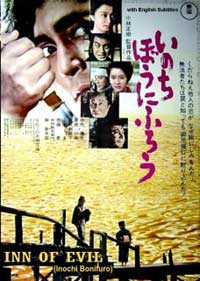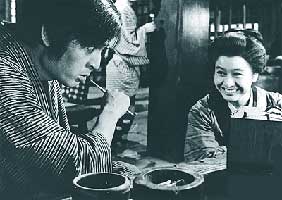 Fukagawa Easy Tavern is a notorious inn on the edge of town, on a little island on the river.
Fukagawa Easy Tavern is a notorious inn on the edge of town, on a little island on the river.
It's a hang-out for thugs who make the place dangerous specifically so outsiders won't want to hang around & discover their smuggling operation.
Inn of Evil (Inochi bo ni furo, 1971) filmed in stark black & white establishes the setting foremost, moody with its black & white cinematography.
The majority of the story is so restricted in location that it sometimes seems ninety percent stage play. And a good one thanks to the cast & its serious tone.
A new group of government magistrates have been assigned to the area. They know they must eventually risk their lives to break the smugglers' hold on the small river island, accessible by one small bridge leading to the inn, the island's only building.
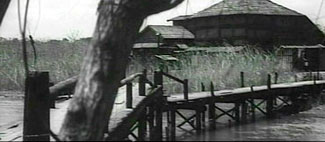 The thugs living at the Easy Tavern inn are badly paid for their criminal services, & miserably treated as expendable by a crime-boss they know mostly through messengers. The thugs living at the Easy Tavern inn are badly paid for their criminal services, & miserably treated as expendable by a crime-boss they know mostly through messengers.
Sadashichi the Indifferent (Tatsuya Nakadai) is a dagger expert who seems always on the verge of a psychotic break, yet he cares about those men under him, & doesn't appreciate that their higher criminal boss's last plan to take a ship's cargo got two of his men killed.
So he tells the boss's messenger his men aren't interested in the next job, certainly not if they're again to be paid only 5 ryo each to get valuable cargo off the Dutch ship.
The character array is well played. Mustached Yunosuke (Daigo Kusano) was "raised under a parasol," a saying that indicates homelessness.
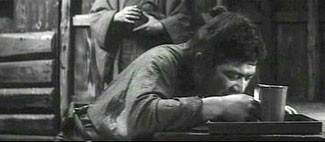 There's the tubercular ronin Genzo (Shin Kishida), the big brute Masaji (Yosuke Kondo), & the dreamily bored maid Omitsu (Komaki Kurihara). There's the tubercular ronin Genzo (Shin Kishida), the big brute Masaji (Yosuke Kondo), & the dreamily bored maid Omitsu (Komaki Kurihara).
There are others, including especially Yohei (Kei Sato), who likens himself "the living buddha." He is famously bisexual. Man or woman, if it's beautiful, he'll sleep with it.
Young Tomijiro (Kei Yamamamoto) is a would-be pickpocket, a young man of the merchant class who whines about his bad luck & induces the rough men to tease him heartlessly. The reason he attempted to be a pickpocket was to get the money to redeem his girlfriend Okiwa (Wakako Sakai) from a bordello.
Slowly those rough men begin to see a spark of ideality not yet stamped out of Tomijiro's spirit. The young man starts to inspire the downtrodden gangsters, so that they begin longing to assist him in saving his woman.
The irony is that their collectively unselfish motivation for finally taking on a dangerous job is to be the downfall of the whole lot, for the world inside the Inn of Evil is ultimately more generous than the world outside.
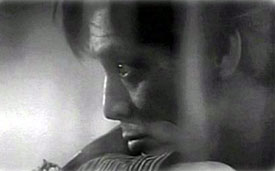 Ikuzo (Kanemon Nakamura), an old bandit chief on his last legs & reduced to the role of innkeeper, regards these men as "wild animals, not evil criminals." Ikuzo (Kanemon Nakamura), an old bandit chief on his last legs & reduced to the role of innkeeper, regards these men as "wild animals, not evil criminals."
They all have sob stories, & are sympathetic beasts. But evil is certainly possible, as when Nakadai's character Sadashichi kills officer Okajima (Ichiro Nakaya), knifing him in the back.
And yet after so easily murdering a man, Sada saves a baby sparrow, protecting it with wild eyes of wonder, while a drunken stranger weeps pondering the bird's mother searching for its baby.
The nameless drunken stranger is played Shintaro Katsu of Zatoichi fame. When first he arrives, the thugs kick him out, since Easy Tavern is their private headquarters. He's stubborn & comes back, demanding sake. He says, "This is my second visit here. You can't say you don't know me." He's cheaky, apparently depressed, but formidable.
With so many finely drawn characters in play, the story develops around their personalities rather than around action, so that the bulk of the tale is more like Kurosawa's actionless The Lower Depths (Donzoko, 1957) rather than a tale of heroics & swordplay.
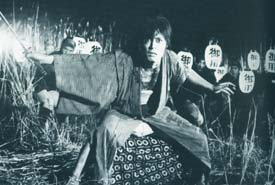 It can seem burdensomely slow if one expected samurai action, but patience pays off both in the richness of the character performers, & eventually even for the almost haunted night-time action scenes on the river toward the climax. It can seem burdensomely slow if one expected samurai action, but patience pays off both in the richness of the character performers, & eventually even for the almost haunted night-time action scenes on the river toward the climax.
The night photography through the river shallows & rushes & along the bridge & paths is visually stunning, especially after the claustrophobic bulk of the film.
The main one-on-one encounter will be Sada versus the head officer (Shigeru Koyama), though for most the demise of the gang is done with full-out tragedy of helplessness, without heroics, the sole heroism being their willingness to act for a selfless reason, the Japanese title actually referring not to the Inn, but to dying without gain.
When their crime has led to such catastrophe, the downtrod gang decides that so long as they can get Tomijiro safely away to liberate his girl, death is worthwhile; it'll be their first, & their last, unselfish act.
It's not the equal of Kobayashi's finest films, as the similarly constructed Samurai Rebellion (Samurai, 1967) has more greatly mesmerizing character performances with a more terrifying action-end; & his masterpiece Hara Kira (Seppuku, 1962) is unexcelled for both action & character. But lesser Koyabayashi would be the masterpiece of one's career for many another director.
copyright © by Paghat the Ratgirl
|

